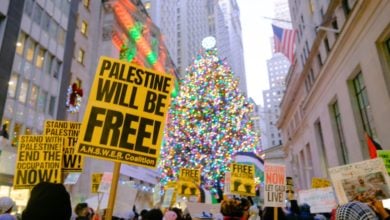Daniel Ellsberg speaking at a press conference in 1972. Photo: Gernard Gotfryd, public domain
Daniel Ellsberg, a high-level military analyst who courageously exposed four administrations’ criminal war on Vietnam and went on to become a leading peace and civil liberties activist, died on June 16 at the age of 92.
Ellsberg was best-known for his 1971 release of 7,000 pages of copies of classified documents, which became famously known as the Pentagon Papers.
The incriminating documents, printed in leading newspapers in the United States and worldwide, showed that U.S. political and military leaders were willing to sacrifice the lives of millions of Vietnamese and tens of thousands of U.S. soldiers rather than admit defeat that many of them knew was inevitable. Working for the Rand Corporation and the State Department, Ellsberg had spent time in Vietnam and seen first-hand the discrepancy between government reports and the reality on the ground.
As early as July 23, 1965, when the massive U.S. troop buildup was just getting under way, Clark Clifford, a close advisor to President Lyndon Johnson, wrote:
“I don’t believe we can win in South Vietnam … If we lose 50,000 men there it will be catastrophic in this country. Five years, billions of dollars, hundreds of thousands of men … I can’t see anything but catastrophe for our nation in this area.”
But, assured by Pentagon generals that if given enough troops and bombs a U.S. victory was certain, Johnson commenced a huge surge that would deploy more than 550,000 troops to Vietnam by 1968. While inflicting unimaginable death and destruction on the country, victory was no closer at the height of the surge than at its beginning, and Johnson was forced out of office.
His successor, Richard Nixon was elected promising to end the war, but had no intention of doing so. While U.S. troops levels in Vietnam were being drawn down at the time of the Pentagon Papers publication in 1971, Nixon was escalating the genocidal air war on the country and contemplating the use of nuclear weapons.
The publication of the Pentagon Papers, titled “History of U.S. Decision-making in Vietnam, 1945-68,” was a bombshell, documenting a quarter-century of lies and deception. Its release enraged Nixon. One of his advisors, Egil Krough, Jr., said later: “We felt so strongly that we were dealing with a national security crisis. Henry Kissinger [then National Security Adviser] said that Dr. Daniel Ellsberg was ‘the most dangerous man in America’ and he had to be stopped.”
A movie titled “The Most Dangerous Man in America: Daniel Ellsberg and the Pentagon Papers,” narrated by Ellsberg himself, was released in 2009.
“Let’s get that son of a bitch into jail,” Nixon told his attorney, John Ehrlichman. “We want to destroy him in the press. Is that clear?”
After the New York Times began printing the papers on June 13, 1971, Nixon’s Attorney General John Mitchell obtained an injunction blocking further publication. But then, the Washington Post began publishing the documents. Later that year, the injunction was vacated by the Supreme Court, a major victory for press freedom.
Meanwhile, a two-week nationwide search for Ellsberg and an associate, Anthony Russo, called in one media report “the largest manhunt since the Lindbergh kidnapping” of the 1930s, ended when they turned themselves in. Both were charged with espionage and other crimes, Ellsberg facing 105 years in prison and Russo 35 years.
Ellsberg was the first target of the White House “Plumbers Unit,” which was secretly established in August 1971, under the leadership of G. Gordon Liddy and E. Howard Hunt, specifically to go after Ellsberg. The “Plumbers” would become infamous for the 1972 break-ins at the Democratic Party’s headquarters in Washington, D.C. — the Watergate scandal that would play a key role in Nixon’s 1974 resignation.
But earlier, on Sept. 3, 1971, the “Plumbers” had broken into the office of Ellsberg’s psychologist in Santa Monica, California, looking for information that Nixon hoped could discredit Ellsberg. When this break-in was revealed during the trial of Ellsberg and Russo in May 1973, it led the judge to dismiss the charges against both defendants.
Daniel Ellsberg and the antiwar movement
As he pointed out, Ellsberg’s decision to release the Pentagon Papers did not take place in a vacuum, but was instead critically influenced by the growing movement against the Vietnam War. He attended his first antiwar rally in 1965 while still working as a Rand analyst, invited by his soon-to-be spouse, Patricia Marx.
An antiwar conference at Haverford College was a turning point for Ellsberg. At the conference, Randy Kehler, a draft resister, stated proudly that he was about to go to prison. “I hadn’t known that he was about to be sentenced for draft resistance,” said Ellsberg in an interview many years later. “It wasn’t what he said exactly that changed my worldview. It was the example that he was setting with his life … there was no question in my mind that my government was involved in an unjust war that was going to continue and get larger. … If I hadn’t met Randy Kehler it wouldn’t have occurred to me to copy [the Pentagon Papers]. His actions spoke to me as no mere words would have done. He put the right question in my mind at the right time.” (Greenfield Recorder, 12/31/2021)
On May Day 1971, just weeks before the release of the Pentagon Papers, Ellsberg was part of an affinity group with Howard Zinn, Noam Chomsky and others at a mass antiwar demonstration in Washington, D.C. He would remain an antiwar activist for the rest of his life, opposing U.S. wars from Latin America to the Middle East. He was arrested more than 90 times in civil disobedience actions.
In a 2018 interview, Ellsberg said, “I think in Iraq, America has never faced up to the number of people who have died because of our invasion, our aggression against Iraq, and Afghanistan over the last 30 years.”
When in 2019 the ANSWER Coalition initiated a mass march and teach-in in Washington, D.C. opposing Trump’s attempt to impose regime change in Venezuela, Ellsberg was the keynote speaker.
Among his many books was “The Doomsday Machine: Confessions of a Nuclear War Planner.” Nuclear war planning was, according to Ellsberg, his main work as a military analyst. In May 2021, seeking another court challenge over the issue of press freedom, Ellsberg posted on the internet a classified 1958 document outlining a Pentagon plan to launch a nuclear war if the People’s Republic of China attempted to reassert control of the province of Taiwan, which had broken away from the mainland after the 1949 Revolution. The assumption of the planners was that such action by the United States would bring a response from the Soviet Union, and thus World War III.
Ellsberg was a staunch supporter of other “whistleblowers” who exposed the criminality of Pentagon/CIA wars and interventions, including Chelsea Manning, Julian Assange and Edward Snowden. He wore a pink feather boa to represent Chelsea Manning at the San Francisco LGBTQ Pride Parade in 2013 and carried a sign that said, “I was Manning: The Pentagon Papers, 1971.” In 2020, Ellsberg testified against the extradition of WikiLeaks publisher Julian Assange to the United States.
In a 2018 interview, he called upon others in the national security apparatus who know about criminal actions being planned or enacted to come forward:
“My message to them is: Don’t do what I did. Don’t wait ’til the bombs are actually falling or thousands more have died, before you do what I wish I had done years earlier, in ’64 or even ’61, on the nuclear issue. And that is, reveal the truth that you know, the dangerous truths that are being withheld by the government, at whatever cost to yourself, whatever risk that may take. Consider doing that, because a war’s worth of lives may be at stake. Or in the case of the two existential crises I’m talking about, the future of humanity is at stake.”






